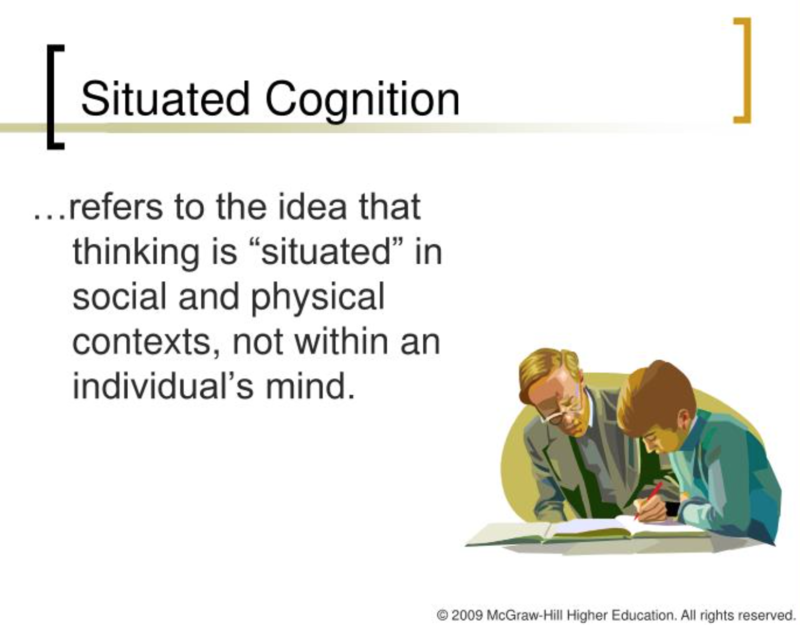e-Learning Ecologies MOOC’s Updates
Situated Cognition
https://www.slideserve.com/zahina/chapter-10
Situated Cognition (SC) is a theoretical construct which encompasses various viewpoints and interpretations, with a general base assumption “that cognition is inherently tied to the social and cultural contexts in which it occurs” (Cobb, 2001). Thus our learning is perceptually tied and know-able through our sensory, emotional and physical experiences in the social world. (Gee, 2010).
According to Brown, et al (1989) learning is a process of enculturation that requires the use of specific tools within authentic activities in a specific socio-cultural context. The concepts, activities and tools are utilised within a relevant cultural domain are quite specific because the domain is what gives meaning and also what prompts cognition. The acknowledge that the ideas presented in ‘Situated Cognition and The Culture of Learning’ builds on activity theory of Vygotsky, Leontiev, et al and the work of Rogoff and Lave, Scribner, Engestrom, Hutchins and Lave and Wenger. A challenge for Brown, et al was the abstraction of knowledge from its context or specific domain, that occurred within schools. They saw this as a hindrance to learning and "robust knowledge" making.
Focusing on learning environments in music development and education we can see that a learner can go through a process of ‘guided participation’ (Rogoff, 1990; cited in Hargreaves, et al, 2003). Where learning can be guided within various socio-cultural contexts of application. This process, according the authors is ‘epitomised by a shift from a Piagetian theory to a Vygotskyan perspective’ (Hargreaves, et al, 2003).
Two pedagogic models were key to Brown, et al's (1989) initial conception of Situated Cognition i.e. cognitive apprenticeships and collaborative learning. Cognitive apprenticeship models attempt to use ‘authentic activities, within social communities and interactions (such as classrooms, online, craft makers, etc) and this is aimed at authentic practice. This is enabled through collaboratively working with learners or practitioners to actively solve or find new problems. it is important to note that as far as Brown et al’s reference to tools they are not only limited to physical tools but are ‘representations’ which can be conceptual tools. Methods like cognitive apprenticeship are essentially also tools in this sense. From here we can see the link to Communities of Practice (Lave and Wenger, 1998) and work on Situated Learning which serve as further models for enculturation and authentic practices as collaborative and deep learning spaces.
https://www.thesimsresource.com/artists/TabbyLou/
I came across the story of Tabby Lou in The Anti-Education Era (James P. Gee, 2010). Gee describes Tabby Lou as a 'shut-in' grandmother who discovers an 'affinity space' in relation to a real-world problem Her granddaughter needed a 'purple pottie' for her 'Sims' family but there none available. Tabby Lou eventually starts playing The Sims and gets hooked. She then explores the possibility of finding 'interest-driven and passion-fueled' spaces where she could be mentored, learn how to learn about making and designing various items for The Sims. She undergoes a 'cognitive apprenticeship' that sees her 'become a techwiz, an artist and a mentor' - one of the biggest designers for The Sims.
“Affinity spaces, at their best, are key examples of synchronized intelligence. Multiple tools, different types of people, and diverse skill sets are networked in ways that make everyone smarter and make the space itself a form of emergent intelligence. The sum is more than its parts; the collective is smarter than the smartest person in it”
Excerpt From: James Paul Gee. “The Anti-Education ERA.” iBooks.
SOURCES:
https://www.slideserve.com/zahina/chapter-10 (accessed 22 April 2018)
Situated Cognition from Wikipedia - https://en.wikipedia.org/wiki/Situated_cognition#Knowing
Seely Brown, J., Collins, A. and Duguid, P., 1989. Situated cognition and the culture of learning. Educational researcher, 18 (1), pp.32-42.
Cobb, P., 2001. Situated cognition: Origins.
Gee, J.P., 2009. New digital media and learning as an emerging area and" worked examples" as one way forward. Mit Press.
Gee, J.P., 2013. The anti-education era: Creating smarter students through digital learning. St. Martin's Press.
Hargreaves, D.J., Marshall, N.A. and North, A.C., 2003. Music education in the twenty-first century: a psychological perspective. British Journal of Music Education, 20(2), pp.147-163.
Lave, J. and Wenger, E., 1998. Communities of practice. Retrieved June, 9, p.2008.




I strongly agree with you that in order to ensure life long learning we need to embed it into real life application of concepts learned. It is also important that the learning should be for a purpose along with being contextual and the best way is to link it to Inquiry or problem solving.